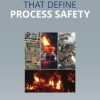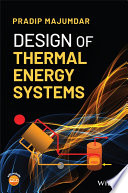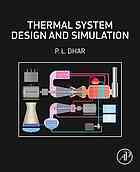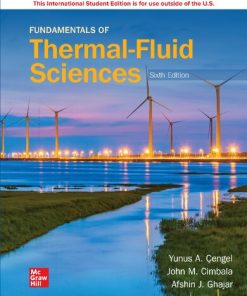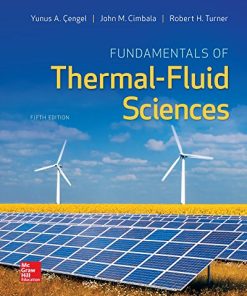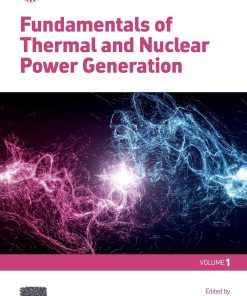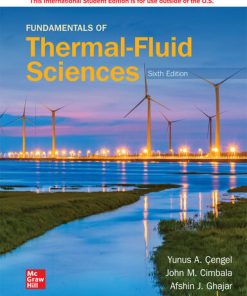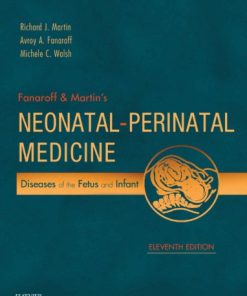(EBook PDF) Thermal Systems Design Fundamentals and Projects 2nd Edition by Richard Martin 1119803497 9781119803492 full chapters
$50.00 Original price was: $50.00.$25.00Current price is: $25.00.
Thermal Systems Design: Fundamentals and Projects 2nd Edition by Richard J. Martin – Ebook PDF Instant Download/DeliveryISBN: 1119803497, 9781119803492
Full download Thermal Systems Design: Fundamentals and Projects 2nd Edition after payment
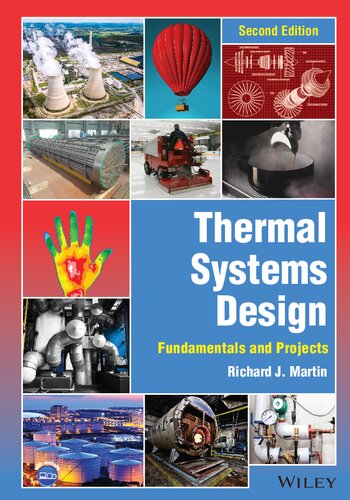
Product details:
ISBN-10 : 1119803497
ISBN-13 : 9781119803492
Author: Richard J. Martin
Thermal Systems Design
Discover a project-based approach to thermal systems design
In the newly revised Second Edition of Thermal Systems Design: Fundamentals and Projects, accomplished engineer and educator Dr. Richard J. Martin offers senior undergraduate and graduate students an insightful exposure to real-world design projects. The author delivers a brief review of the laws of thermodynamics, fluid mechanics, heat transfer, and combustion before moving on to a more expansive discussion of how to apply these fundamentals to design common thermal systems like boilers, combustion turbines, heat pumps, and refrigeration systems.
Thermal Systems Design: Fundamentals and Projects 2nd Table of contents:
1 Thermodynamics
1.1 Units of Measure
1.2 Mass/Force Unit Conversion
1.3 Standard Temperature and Pressure
1.4 Control Mass, Control Volume
1.5 Laws of Thermodynamics
1.6 Conservation Laws
1.7 Thermodynamic Variable Categories
1.8 Ideal Gas Law
1.9 History of Temperature
1.10 Thermodynamic States
1.11 Internal Energy, Enthalpy, Entropy
1.12 Availability (Exergy)
1.13 Homework Problems
Cited References
2 Fluid Mechanics
2.1 Viscosity, Shear, Velocity
2.2 Hydrostatics, Buoyancy
2.3 The Continuity Equation
2.4 Mass, Volume, Mole Flows
2.5 Reynolds Number, Velocity Profiles
2.6 The Momentum Equation
2.7 Bernoulli’s Equation
2.8 Stagnation, Static, Dynamic Pressure
2.9 Friction Factor, Hydraulic Diameter
2.10 Moody Chart, Chen Equation
2.11 Modified Bernoulli Equation
2.12 Alternate Moody Charts
2.13 Entry Effects, Minor Losses
2.14 Porous Media Pressure Drop
2.15 Homework Problems
Cited References
3 Heat Transfer
3.1 Fourier’s Law
3.2 Newton’s Law of Cooling
3.3 The Stefan–Boltzmann Law
3.4 The Energy Equation
3.5 The Entropy Equation
3.6 Electricity Analogy for Heat
3.7 Film, Mean Temperature
3.8 Nusselt, Prandtl Numbers
3.9 Flows Across Tube Banks
3.10 “Gotcha” Variables
3.11 Radiation and Natural Convection
3.12 Radiant Exchange
3.13 Types of Heat Exchangers
3.14 Heat Exchanger Fundamentals
3.15 Overall Heat Transfer Coefficient
3.16 LMTD Method
3.17 Effectiveness‐NTU Method
3.18 Porous Media Heat Transfer
3.19 External Convection to Individual Spheres and Cylinders
3.20 Homework Problems
Cited References
4 Introduction to Combustion
4.1 Fuels for Combustion
4.2 Air for Combustion
4.3 Atomic and Molar Mass
4.4 Balancing Chemical Equations
4.5 Stoichiometry and Equivalence Ratio
4.6 The Atom Equations
4.7 Sensible and Chemical Enthalpies
4.8 Thermochemical Property Tables
4.9 Enthalpy of Combustion
4.10 Enthalpy Datum States
4.11 Adiabatic Combustion Temperature
4.12 Equilibrium and Kinetics
4.13 Pollutant Formation and Control
4.14 Combustion Safety Fundamentals
4.15 Other Topics in Combustion
4.16 Homework Problems
Cited References
5 Process Flow Diagrams
5.1 Intelligent CAD
5.2 Equipment
5.3 Process Lines
5.4 Valves and Instruments
5.5 Nonengineering Items
5.6 Heat and Material Balance
5.7 PFD Techniques
5.8 Homework Problems
Cited References
6 Advanced Thermodynamics
6.1 Equations of State
6.2 Thermodynamic Property Diagrams
6.3 Gibbs, Helmholtz, and Maxwell
6.4 Equations of State
6.5 Boiling and Condensation
6.6 Psychrometry
6.7 Liquid–Vapor Equilibrium for NH 3 + H 2 O Mixtures
6.8 Efficiency vs Effectiveness
6.9 Space vs Time
6.10 Homework Problems
Cited References
7 Burners and Heat Recovery
7.1 Burners
7.2 Combustion Safeguarding
7.3 Thermal Oxidizers
7.4 Destruction Efficiency
7.5 Recuperators and Regenerators
7.6 Packed‐bed Heat Storage
7.7 Heat Exchanger Discretization
7.8 Thermal Destruction of Airborne Pathogens
7.9 Special Atmosphere Heat Treating
7.10 Burner and Heat Exchanger Failures
7.11 Homework Problems
Cited References
8 Boilers and Power Cycles
8.1 Rankine Cycle
8.2 Boiler Terminology
8.3 Efficiency Improvement
8.4 Controls and Safeguards
8.5 Blowdown and Water Treatment
8.6 Air Pollutant Reduction
8.7 Organic Rankine Cycle
8.8 Boiler Failure Analysis
8.9 Homework Problems
Cited References
9 Combustion Turbines
9.1 Turbomachinery
9.2 Brayton Cycle
9.3 Polytropic Processes
9.4 Isentropic Efficiency
9.5 Gas Property Relationships
9.6 Reheating, Intercooling
9.7 Recuperation
9.8 Homework Problems
Cited References
10 Refrigeration and Heat Pumps
10.1 Vapor Refrigeration Cycle
10.2 Gas Refrigeration Cycle
10.3 Heat Pump Efficiency
10.4 Sizing and Energy Usage
10.5 Refrigerants
10.6 Compressors
10.7 Air Handlers
10.8 Refrigeration Control
10.9 Coil Defrost
10.10 Compressorless Refrigeration
10.11 Thermoelectric Coolers
10.12 Refrigeration System Failures
10.13 Homework Problems
Cited References
11 Other Thermal Systems
11.1 Solar Fluid Heating
11.2 Fluid Heaters
11.3 Evaporative Cooling
11.4 Geothermal Heat Sink
11.5 Thermal Energy Storage
11.6 Thick‐layer Product Dehydration
11.7 Desalination
11.8 Steam Sterilization
11.9 Espresso Machine
11.10 Hot Air Balloon
11.11 Homework Problems
Cited References
12 Pipe and Fluid Mover Analysis
12.1 Fluid Mover Categories
12.2 Conveying Means Categories
12.3 Leak Prevention
12.4 Pressure Rise and Drop
12.5 Electricity Analogy for Flow
12.6 Piping Network Rules
12.7 Blower and System Curves
12.8 Pump and Blower Work
12.9 Compressibility in Long Pipes
12.10 Chimney Effect
12.11 Homework Problems
Cited References
13 Thermal Protection
13.1 Refractory Ceramics
13.2 Refractory Metals
13.3 Thermal Insulation
13.4 Radiative‐Convective Insulation Systems
13.5 Skin Contact Burns
13.6 Protection Against Thermal Expansion
13.7 Protection Against Thermal Shock
13.8 Homework Problems
Cited References
14 Piping and Instrumentation Diagrams
14.1 Design Packages
14.2 Temperature Sensors
14.3 Pressure Sensors
14.4 Flow Sensors
14.5 Level Sensors
14.6 Exhaust Gas Analyzers
14.7 Combustion Safety Instruments
14.8 Valves and Actuators
14.9 ISA Tag Glossary
14.10 P&ID Techniques
14.11 Homework Problems
Cited References
15 Control of Thermal Systems
15.1 Control Nomenclature
15.2 Thermostatic Control
15.3 PID Control
15.4 Safety Controls and Interlocks
15.5 Sequencing Control
15.6 Ladder Logic
15.7 Homework Problems
Cited References
16 Process Safety
16.1 Safety Terminology
16.2 Safety Hierarchy
16.3 Safeguards and Warnings
16.4 History of Safety Standards
16.5 Process Hazard Analysis
16.6 Homework Problems
Cited References
17 Process Quality Methods
17.1 Quality Terminology
17.2 Advanced Statistical Methods for Quality in Thermal Processes
17.3 Management of Change for Quality, Stewardship, and Safety
17.4 Homework Problems
Cited References
18 Procurement, Operation, and Maintenance
18.1 Engineering Design Deliverable
18.2 Engineering Data Sheets
18.3 Construction and Commissioning
18.4 Inspection, Maintenance, and Training
18.5 Operation and Maintenance Manual
18.6 Homework Problems
People also search for Thermal Systems Design: Fundamentals and Projects 2nd:
thermal systems design
thermal energy systems design and analysis pdf
thermal energy systems design and analysis
c&r thermal desktop
cfd thermal analysis
Tags:
Thermal,Systems Design,Fundamentals,Projects,Richard Martin
You may also like…
Uncategorized
Computers - Home Computer User & Beginner
Engineering - Energy & Power Resources
Engineering
Fundamentals of Thermal Fluid Sciences 6th Edition by Yunus Cengel 1264131348 9781264131341
Business & Economics - Industries
Fundamentals of Thermal and Nuclear Power Generation 1st edition



